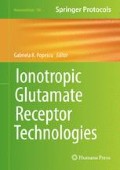Abstract
During receptor channel activation, the receptor goes through a ligand binding step followed by conformation steps leading to the open channel conformation. The probability of finding the receptor in a particular conformation is given by the apparent rate constants. The apparent rate constants describe the rate of transitions between conformational states and vary among different types of iGluR. To determine these parameters reflecting receptor channel function, several approaches have been developed. In this chapter we describe methods for the measurement of basic kinetic parameters of the NMDA receptor determined from non-stationary analysis of whole-cell currents. Particularly, the apparent rate constants of agonist binding/unbinding, desensitization/resensitization, and the probability of channel opening are determined. Besides the kinetic parameters of the receptor, the number of ion channels in the cell membrane and single-channel conductance are estimated from whole-cell recordings.
Access this chapter
Tax calculation will be finalised at checkout
Purchases are for personal use only
References
Armstrong N, Gouaux E (2000) Mechanisms for activation and antagonism of an AMPA-sensitive glutamate receptor: crystal structures of the GluR2 ligand binding core. Neuron 28(1):165–181
Mayer ML (2005) Crystal structures of the GluR5 and GluR6 ligand binding cores: molecular mechanisms underlying kainate receptor selectivity. Neuron 45(4):539–552
Karakas E, Furukawa H (2014) Crystal structure of a heterotetrameric NMDA receptor ion channel. Science 344(6187):992–997
Meyerson JR et al (2014) Structural mechanism of glutamate receptor activation and desensitization. Nature 514:328–334
Lee C-H et al (2014) NMDA receptor structures reveal subunit arrangement and pore architecture. Nature 511(7508):191–197
Mayer ML (2006) Glutamate receptors at atomic resolution. Nature 440(7083):456–462
Mayer ML, Armstrong N (2004) Structure and function of glutamate receptor ion channels. Annu Rev Physiol 66:161–181
Furukawa H et al (2005) Subunit arrangement and function in NMDA receptors. Nature 438(7065):185–192
Hamill OP et al (1981) Improved patch-clamp techniques for high-resolution current recording from cells and cell-free membrane patches. Pflugers Arch 391(2):85–100
Sakmann B, Neher E (1984) Patch clamp techniques for studying ionic channels in excitable membranes. Annu Rev Physiol 46:455–472
Vyklicky V et al (2013) Structure, function, and pharmacology of NMDA receptor channels. Physiol Res 63:S191–S203
Molecular Devices Corporation (2006) The axon CNS guide to electrophysiology & biophysics laboratory techniques. Molecular Devices Corporation, Union City
Molnar P, Hickman JJ (2007) Patch-clamp methods and protocols. Humana, New York
Sachs F (1999) Practical limits on the maximal speed of solution exchange for patch clamp experiments. Biophys J 77(2):682–690
Auzmendi J et al (2012) Achieving maximal speed of solution exchange for patch clamp experiments. PloS one 7(8):e42275
Lester RA, Jahr CE (1992) NMDA channel behavior depends on agonist affinity. J Neurosci 12(2):635–643
Popescu G et al (2004) Reaction mechanism determines NMDA receptor response to repetitive stimulation. Nature 430(7001):790–793
Auerbach A, Zhou Y (2005) Gating reaction mechanisms for NMDA receptor channels. J Neurosci 25(35):7914–7923
Kussius CL, Kaur N, Popescu GK (2009) Pregnanolone sulfate promotes desensitization of activated NMDA receptors. J Neurosci 29(21):6819–6827
Huettner JE, Bean BP (1988) Block of N-methyl-D-aspartate-activated current by the anticonvulsant MK-801: selective binding to open channels. Proc Natl Acad Sci U S A 85(4):1307–1311
Jahr CE (1992) High probability opening of NMDA receptor channels by L-glutamate. Science 255(5043):470–472
Rosenmund C, Feltz A, Westbrook GL (1995) Synaptic NMDA receptor channels have a low open probability. J Neurosci 15(4):2788–2795
Gielen M et al (2009) Mechanism of differential control of NMDA receptor activity by NR2 subunits. Nature 459(7247):703–707
Nowak L et al (1984) Magnesium gates glutamate-activated channels in mouse central neurones. Nature 307(5950):462–465
Usowicz MM, Gallo V, Cull Candy SG (1989) Multiple conductance channels in type-2 cerebellar astrocytes activated by excitatory amino acids. Nature 339(6223):380–383
Stern P et al (1992) Single-channel conductances of NMDA receptors expressed from cloned cDNAs: comparison with native receptors. Proc R Soc Lond B Biol Sci 250(1329):271–277
Stern P et al (1994) Single channel properties of cloned NMDA receptors in a human cell line: comparison with results from Xenopus oocytes. J Physiol 476(3):391–397
Wyllie DJ et al (1996) Single-channel currents from recombinant NMDA NR1a/NR2D receptors expressed in Xenopus oocytes. Proc R Soc Lond B Biol Sci 263(1373):1079–1086
Clark BA, Farrant M, Cull-Candy SG (1997) A direct comparison of the single-channel properties of synaptic and extrasynaptic NMDA receptors. J Neurosci 17(1):107–116
Robinson HP, Sahara Y, Kawai N (1991) Nonstationary fluctuation analysis and direct resolution of single channel currents at postsynaptic sites. Biophys J 59(2):295–304
Sigworth FJ (1980) The variance of sodium current fluctuations at the node of Ranvier. J Physiol 307:97–129
Abdrachmanova G et al (2000) Molecular and functional properties of synaptically activated NMDA receptors in neonatal motoneurons in rat spinal cord slices. Eur J Neurosci 12(3):955–963
Silver RA, Traynelis SF, Cull Candy SG (1992) Rapid-time-course miniature and evoked excitatory currents at cerebellar synapses in situ. Nature 355(6356):163–166
Vyklicky L Jr (1993) Calcium-mediated modulation of N-methyl-D-aspartate (NMDA) responses in cultured rat hippocampal neurones. J Physiol 470:575–600
Gibb AJ, Colquhoun D (1992) Activation of N-methyl-D-aspartate receptors by L-glutamate in cells dissociated from adult rat hippocampus. J Physiol 456:143–179
Cais O et al (2008) Temperature dependence of NR1/NR2B NMDA receptor channels. Neuroscience 151(2):428–438
Sather W et al (1992) Activation and desensitization of N-methyl-D-aspartate receptors in nucleated outside-out patches from mouse neurones. J Physiol 450:643–672
Acknowledgments
Work on this chapter was supported by the GACR (P303/12/1464, P303/11/P391), RP (RVO: 67985823), TACR (TE01020028), BIOCEV (CZ.1.05/1.1.00/02.0109), and GAUK 800313/2012/2.lF. We thank J. Krusek for helpful discussions and commentary.
Author information
Authors and Affiliations
Corresponding author
Editor information
Editors and Affiliations
Rights and permissions
Copyright information
© 2016 Springer Science+Business Media New York
About this protocol
Cite this protocol
Vyklicky, V., Korinek, M., Balik, A., Smejkalova, T., Krausova, B., Vyklicky, L. (2016). Analysis of Whole-Cell NMDA Receptor Currents. In: Popescu, G. (eds) Ionotropic Glutamate Receptor Technologies. Neuromethods, vol 106. Humana Press, New York, NY. https://doi.org/10.1007/978-1-4939-2812-5_14
Download citation
DOI: https://doi.org/10.1007/978-1-4939-2812-5_14
Publisher Name: Humana Press, New York, NY
Print ISBN: 978-1-4939-2811-8
Online ISBN: 978-1-4939-2812-5
eBook Packages: Springer Protocols

